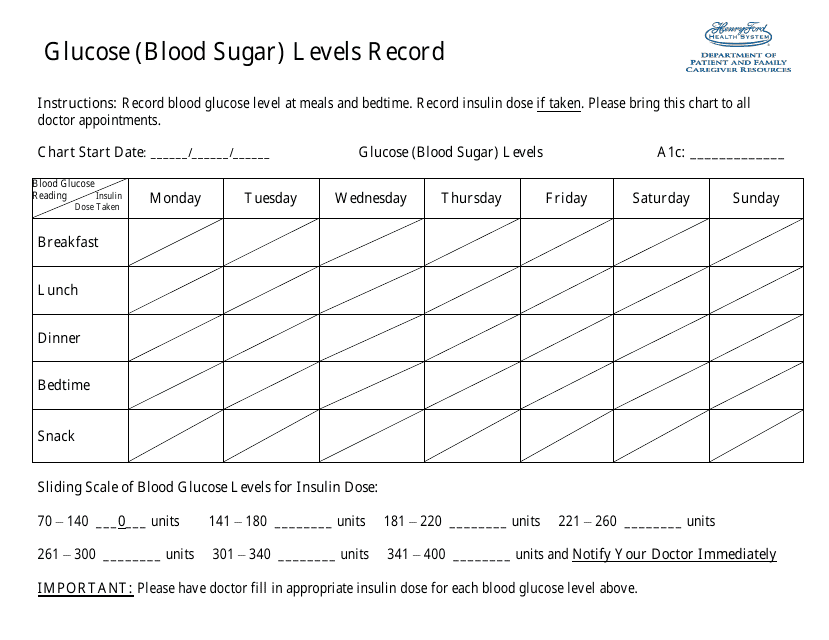Glucose (Blood Sugar) Levels Record - Department of Patient and Family Caregiver Resources
The Glucose (Blood Sugar) Levels Record from the Department of Patient and Family Caregiver Resources is designed to help individuals with diabetes track their blood sugar levels over a period of time. This document is essential for monitoring and managing your diabetes effectively.
It allows you to note down your glucose readings at different times of the day, typically before and after meals and before bedtime. Regular recording of blood sugar levels in this document provides a useful piece of information for healthcare providers to assess your diabetes management plan and make any necessary adjustments.
Moreover, it helps individuals understand how their diet, exercise, medication, and lifestyle affect their blood sugar levels. This knowledge can empower patients to take control of their health and make informed decisions.
The Glucose (Blood Sugar) Levels Record is typically filed by a healthcare professional such as a nurse or doctor in the Department of Patient and Family Caregiver Resources. It can also be filed by the patient or their family caregiver if they have been trained to check blood sugar levels at home. However, the practices may vary based on the specific rules and regulations of the healthcare facility in different countries. Patients are generally encouraged to maintain their own records for personal reference and to share with their healthcare team during appointments.
FAQ
Q: What is the purpose of the Glucose (Blood Sugar) Levels Record?
A: The Glucose (Blood Sugar) Levels Record is used for tracking and managing the glucose levels over a certain period to help with the diagnosis, prevention, and treatment of diabetes. It provides important information to healthcare professionals to monitor individual health condition.
Q: Who can use the Glucose (Blood Sugar) Levels Record?
A: The Glucose (Blood Sugar) Levels Record can be utilized by individuals who have been diagnosed with diabetes or those who are at risk, such as those with a family history of diabetes, those who are overweight, or those who suffer from other health conditions like high blood pressure.
Q: How do you maintain a Glucose (Blood Sugar) Levels Record?
A: A person can maintain a Glucose (Blood Sugar) Levels Record by checking their blood sugar levels regularly at different times of the day, typically before and after meals and physical activities. These readings should be recorded along with the date, time, and any relevant notes like food intake or physical activity performed.
Q: How does the Department of Patient and Family Caregiver Resources use the Glucose (Blood Sugar) Levels Record?
A: The Department of Patient and Family Caregiver Resources uses the Glucose (Blood Sugar) Levels Record to monitor patient blood sugar levels over time, identify patterns and fluctuations, and adjust diet, exercise, and medication plans as necessary. This allows for more comprehensive and personalized patient care.
Q: What is considered a normal blood glucose level?
A: According to the American Diabetes Association, a normal blood sugar level for people without diabetes is approximately 80-130 mg/dL before meals, and less than 180 mg/dL two hours after starting a meal. However, what's considered normal can vary, and people with diabetes generally aim to keep their blood sugar levels within a range that's set with their healthcare provider.
Q: Why is it important to monitor blood glucose levels?
A: Monitoring blood glucose levels is crucial for managing diabetes, as it helps to understand the impact of food, physical activity, medication, and stress on blood sugar levels. Regular monitoring can help to prevent diabetes complications like heart disease, kidney damage, and nerve damage. It can also provide invaluable information to healthcare providers for making treatment adjustments.




